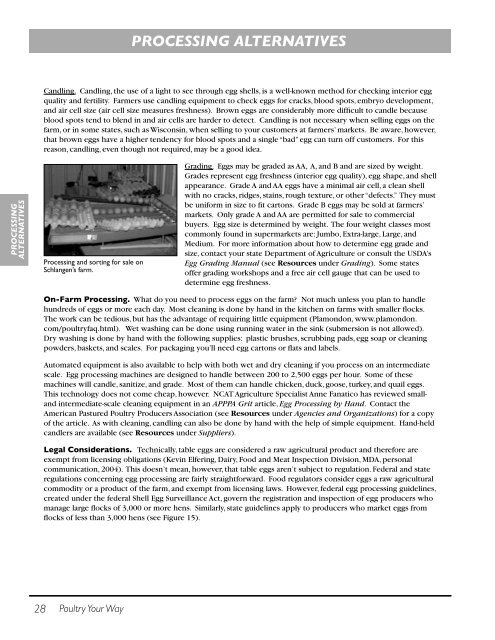Poultry Your Way - Center for Integrated Agricultural Systems ...
Poultry Your Way - Center for Integrated Agricultural Systems ...
Poultry Your Way - Center for Integrated Agricultural Systems ...
You also want an ePaper? Increase the reach of your titles
YUMPU automatically turns print PDFs into web optimized ePapers that Google loves.
PROCESSING<br />
ALTERNATIVES<br />
28<br />
<strong>Poultry</strong> <strong>Your</strong> <strong>Way</strong><br />
PROCESSING ALTERNATIVES<br />
Candling. Candling, the use of a light to see through egg shells, is a well-known method <strong>for</strong> checking interior egg<br />
quality and fertility. Farmers use candling equipment to check eggs <strong>for</strong> cracks, blood spots, embryo development,<br />
and air cell size (air cell size measures freshness). Brown eggs are considerably more difficult to candle because<br />
blood spots tend to blend in and air cells are harder to detect. Candling is not necessary when selling eggs on the<br />
farm, or in some states, such as Wisconsin, when selling to your customers at farmers’ markets. Be aware, however,<br />
that brown eggs have a higher tendency <strong>for</strong> blood spots and a single “bad” egg can turn off customers. For this<br />
reason, candling, even though not required, may be a good idea.<br />
Processing and sorting <strong>for</strong> sale on<br />
Schlangen’s farm.<br />
Grading. Eggs may be graded as AA, A, and B and are sized by weight.<br />
Grades represent egg freshness (interior egg quality), egg shape, and shell<br />
appearance. Grade A and AA eggs have a minimal air cell, a clean shell<br />
with no cracks, ridges, stains, rough texture, or other “defects.” They must<br />
be uni<strong>for</strong>m in size to fit cartons. Grade B eggs may be sold at farmers’<br />
markets. Only grade A and AA are permitted <strong>for</strong> sale to commercial<br />
buyers. Egg size is determined by weight. The four weight classes most<br />
commonly found in supermarkets are: Jumbo, Extra-large, Large, and<br />
Medium. For more in<strong>for</strong>mation about how to determine egg grade and<br />
size, contact your state Department of Agriculture or consult the USDA’s<br />
Egg Grading Manual (see Resources under Grading). Some states<br />
offer grading workshops and a free air cell gauge that can be used to<br />
determine egg freshness.<br />
On-Farm Processing. What do you need to process eggs on the farm? Not much unless you plan to handle<br />
hundreds of eggs or more each day. Most cleaning is done by hand in the kitchen on farms with smaller flocks.<br />
The work can be tedious, but has the advantage of requiring little equipment (Plamondon, www.plamondon.<br />
com/poultryfaq.html). Wet washing can be done using running water in the sink (submersion is not allowed).<br />
Dry washing is done by hand with the following supplies: plastic brushes, scrubbing pads, egg soap or cleaning<br />
powders, baskets, and scales. For packaging you’ll need egg cartons or flats and labels.<br />
Automated equipment is also available to help with both wet and dry cleaning if you process on an intermediate<br />
scale. Egg processing machines are designed to handle between 200 to 2,500 eggs per hour. Some of these<br />
machines will candle, sanitize, and grade. Most of them can handle chicken, duck, goose, turkey, and quail eggs.<br />
This technology does not come cheap, however. NCAT Agriculture Specialist Anne Fanatico has reviewed small-<br />
and intermediate-scale cleaning equipment in an APPPA Grit article, Egg Processing by Hand. Contact the<br />
American Pastured <strong>Poultry</strong> Producers Association (see Resources under Agencies and Organizations) <strong>for</strong> a copy<br />
of the article. As with cleaning, candling can also be done by hand with the help of simple equipment. Hand-held<br />
candlers are available (see Resources under Suppliers).<br />
Legal Considerations. Technically, table eggs are considered a raw agricultural product and there<strong>for</strong>e are<br />
exempt from licensing obligations (Kevin Elfering, Dairy, Food and Meat Inspection Division, MDA, personal<br />
communication, 2004). This doesn’t mean, however, that table eggs aren’t subject to regulation. Federal and state<br />
regulations concerning egg processing are fairly straight<strong>for</strong>ward. Food regulators consider eggs a raw agricultural<br />
commodity or a product of the farm, and exempt from licensing laws. However, federal egg processing guidelines,<br />
created under the federal Shell Egg Surveillance Act, govern the registration and inspection of egg producers who<br />
manage large flocks of 3,000 or more hens. Similarly, state guidelines apply to producers who market eggs from<br />
flocks of less than 3,000 hens (see Figure 15).

















